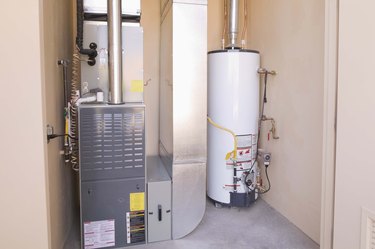
Some gas furnaces need 24 volts to operate the timers, heat controls or ignition circuits. But your home only has 120 volts in its wiring. A furnace transformer reduces your house voltage for use inside your furnace.
Primary Coil
Video of the Day
The house voltage connects across a coil of wires, called the primary of the transformer. As the alternating current (AC) changes directions through the coil, it creates magnetic lines of force that emit from the coil.
Video of the Day
Secondary Coil
As the lines of force pass through another coil called the secondary, they induce or generate electricity into that coil, which provides the output of the transformer.
Core
Both the primary and secondary coils of the transformer wrap around a common metallic core to improve the amount of induction. A magnetized core works even better.
Turns Ratio
The output of the transformer depends on the number of turns of wire in the primary and secondary coils. Ideally, with a ratio of turns of 5-to-1, a furnace transformer reduces 120 volts to 24.
Coil Insulation
The wires in the coils must be insulated to prevent the electricity from shorting. Sometimes the heat generated by the transformer breaks down the insulation, eventually causing it to fail.